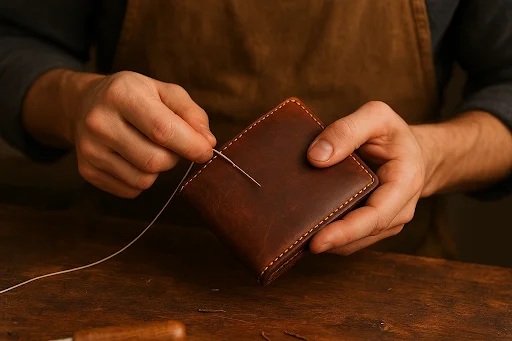You swipe cards, tap your wallet, and slide it into your pocket dozens of times a day. It’s your constant companion — yet, have you ever wondered how long a leather wallet is built to last? With so many options out there — from budget-friendly to high-end — it’s easy to assume they all perform the same. But the truth is, the life of your wallet depends on what’s inside (literally and figuratively).
In this article, we’ll break down the factors that determine a wallet’s lifespan and share expert-backed tips to help you get the most out of your investment. If you’ve ever questioned whether leather wallets are worth the price, keep reading — the answer might surprise you.
What Determines the Lifespan of a Leather Wallet?
The longevity of a leather wallet isn’t a matter of luck — it’s a science of materials, craftsmanship, and how well it’s treated over time. While all leather wallets may look similar at first glance, their durability varies greatly depending on a few key factors. From the type of leather used to the way it’s tanned, stitched, and handled, every detail plays a vital role in how long your wallet will last.
Let’s break down the main elements that determine whether your wallet will stand the test of time or start to show wear after just a few months.
1. Type of Leather: Full-Grain vs. Genuine Leather
The type of leather used is the single biggest factor affecting how long your wallet will last. Not all leather is created equal — some are made to endure for decades, while others are processed in a way that compromises strength and character.
Full-Grain Leather:
This is the highest quality and most durable form of leather. It’s made from the outermost layer of the hide — the same layer that endures years of weather, movement, and wear on the animal. Full-grain leather retains its natural grain and imperfections, which actually make it stronger and more unique. Over time, it develops a rich patina — that soft, glossy finish that comes only with age and use. A full-grain leather wallet can easily last 10–15 years or more with proper care.
Genuine Leather:
Despite the name, “genuine leather” is often lower quality. It’s made from the remaining layers of the hide after the top grain has been removed. To make it look appealing, manufacturers apply artificial coatings, dyes, and finishes. While it might look good initially, genuine leather tends to crack, peel, and lose shape over time, often lasting only a few years.
Verdict:
If longevity and elegance are your goals, full-grain leather is the clear winner. It costs more upfront, but it offers a lifetime of use and character that cheaper leather simply can’t match.
2. Tanning Method: Vegetable-Tanned vs. Chrome-Tanned
Tanning is the process that turns raw animal hides into usable leather. The method used during tanning has a huge impact on how your wallet feels, looks, and lasts.
Vegetable-Tanned Leather:
This method uses natural plant-based tannins (from tree bark and leaves) to preserve the hide. It’s an age-old process that can take weeks, but the result is leather that’s rich, firm, and develops a stunning patina over time. Vegetable-tanned leather wallets are durable, eco-friendly, and often get better with age. With proper maintenance, they can last a decade or more.
Chrome-Tanned Leather:
This process uses chromium salts and chemicals to speed up tanning, allowing manufacturers to produce leather in just a few days. Chrome-tanned leather is softer and more flexible but less durable in the long run. It may fade, crack, or lose structure faster when exposed to moisture or heat.
Verdict:
If you prefer a wallet that grows more beautiful with age and can last for years, go for vegetable-tanned leather. If you prioritize flexibility, softness, and affordability, chrome-tanned leather may work — but it won’t stand the test of time like its vegetable-tanned counterpart.
3. Craftsmanship and Stitching Quality
Even the finest leather won’t last if it’s poorly crafted. The construction quality — how it’s stitched, cut, and finished — determines whether a wallet will hold together for years or fall apart at the seams.
Key indicators of great craftsmanship include:
- Tight, even stitching: Ensures the wallet holds its shape and doesn’t unravel.
- Burnished or edge-coated seams: Prevents fraying and moisture damage.
- Hand-stitched construction: Often stronger and more durable than machine stitching.
- Reinforced stress points: Extra stitching in areas like corners and card slots extends lifespan.
A well-made wallet reflects the attention of skilled artisans. High-end brands that emphasize craftsmanship often test their wallets under various conditions to ensure they can endure years of daily use.
Verdict:
When buy a leather wallet, always examine the stitching, seams, and finishing details. These small signs reveal whether the wallet is built for short-term style or long-term value.
4. Frequency of Use and Handling Habits
Even the strongest leather will show signs of wear if it’s handled roughly or used excessively without care. How you treat your wallet has a direct impact on its lifespan.
Here’s what affects durability in daily life:
- Pocket storage: Keeping your wallet in tight jeans can cause bending, warping, or cracking.
- Moisture exposure: Sweat, rain, or humidity can weaken leather fibers over time.
- Overstuffing: Adding too many cards or receipts stretches the wallet, distorting its shape permanently.
- Surface friction: Constant rubbing against rough fabric or surfaces can dull the finish.
To make your wallet last longer, keep it dry, store it in a breathable pouch when not in use, and avoid stuffing it beyond its capacity. Periodic conditioning with a good-quality leather balm can also restore its natural oils and keep it supple.
Verdict:
A wallet’s longevity isn’t only about where it came from — it’s also about how you use it. Gentle, mindful handling can often double the lifespan of even an average-quality wallet.
Average Lifespan: How Long Do Leather Wallets Really Last?
The average lifespan of a leather wallet can vary dramatically depending on its quality, craftsmanship, and care routine — but as a general rule, a well-made wallet can last anywhere between 3 to 15 years, sometimes even longer.
However, not all leather wallets age the same way. Just like any other natural material, leather evolves over time. It can soften, darken, and develop a patina — that rich, vintage sheen that makes every wallet unique. While these changes are signs of good aging, they also depend on how well you treat your wallet on a daily basis.
Let’s break down what you can expect from different wallet types and quality levels over time.
1. Entry-Level Leather Wallets (1–3 Years)
These wallets are typically made from genuine leather or bonded leather, which means they use leftover hide scraps blended with synthetic materials. They may look stylish when new, but the surface coating often wears off within a year or two. You’ll start noticing peeling edges, faded color, or cracks, especially around frequently used card slots and folds.
While these wallets serve well for short-term use, they’re not built to age gracefully. Most will need replacement within 2–3 years, even with moderate care.
2. Mid-Range Leather Wallets (4–7 Years)
Mid-range wallets often use top-grain leather or lightly treated hides that maintain better durability. With proper use and conditioning, they can last five years or more before showing significant wear.
You may notice the leather becoming softer and developing a light patina over time, which adds character. However, if exposed to constant friction, moisture, or overstuffing, the edges and stitching might still weaken before the decade mark.
This range is ideal for people who want a balance between affordability and quality, as long as they are willing to maintain the leather periodically.
3. Premium Full-Grain Leather Wallets (10–15+ Years)
When it comes to longevity, full-grain leather is unmatched. These wallets can easily last a decade or two with regular conditioning and mindful use. Because full-grain leather comes from the strongest part of the hide, it’s naturally resistant to tearing and cracking.
Over time, it develops a deep, luxurious patina that enhances its aesthetic appeal rather than diminishing it. In fact, many leather enthusiasts love how these wallets tell a story — the natural aging process gives them personality, not flaws.
Premium branded wallets, especially those made with hand stitching and vegetable-tanned leather, have been known to last over 20 years, becoming heirloom-quality pieces passed down through generations.
4. Factors That Can Shorten or Extend Lifespan
Even the finest leather wallet can deteriorate early if not treated properly. A few habits that can shorten its life include:
- Keeping it in damp or humid conditions.
- Overstuffing with cards and receipts.
- Leaving it in direct sunlight for long periods.
- Neglecting conditioning or cleaning.
On the flip side, you can easily extend its lifespan by:
- Storing it in a cool, dry place when not in use.
- Cleaning it with a soft cloth and mild leather cleaner.
- Conditioning it every few months to restore natural oils.
- Avoiding overuse of one particular fold or pocket.
Signs It’s Time to Replace Your Leather Wallet
Even the best leather wallet won’t last forever. Over time, daily use, friction, and exposure to the elements can take their toll. Here are a few clear signs it’s time for an upgrade:
- Cracked or Peeling Leather: When the surface starts drying or flaking, it means the leather’s natural oils are gone. Conditioning won’t fix deep cracks — replacement is the only option.
- Faded or Uneven Color: A rich patina is normal, but dull, patchy fading means the protective finish has worn off.
- Loose or Frayed Stitching: If the seams start unraveling, your wallet’s structure won’t hold up much longer.
- Warped Shape: Overstuffing or moisture can distort the wallet’s form, making it bulky and uncomfortable.
- Stretched or Torn Card Slots: Loose slots that no longer grip your cards signal it’s time for a new wallet.
- Bad Odor or Mold: Persistent musty smells or visible mold mean the leather has absorbed too much moisture — best to replace it for hygiene.
- Outdated Design: Sometimes, your wallet simply no longer fits your lifestyle. A slimmer or RFID-protected model might be a better match.
If your wallet looks worn, feels weak, or no longer functions properly, it’s time to retire it and invest in a new one that will serve you — and your style — for years to come.
Conclusion
A good leather wallet isn’t just about looks — it’s about longevity, craftsmanship, and care. With the right leather and proper maintenance, a quality wallet can last 10 years or more, aging beautifully over time.
The secret is simple: invest in quality and care for it well. Regular cleaning, conditioning, and mindful use will keep your wallet strong and stylish for years.
And when it finally shows signs of wear, take it as a mark of good use — and an opportunity to upgrade to a new, timeless piece that fits your evolving style.


